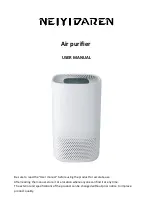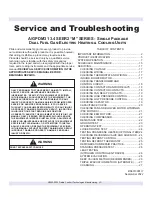
Y2
MV
M
P
R
R
IP
R
Y
P
Circulation pump (not included in the delivery)
Because of the risk of condensing the pump should be suitable
for pumping liquid that is colder than the ambient temperature
(e.g. Magna1 25-60). When choosing a circulation pump, take
into account the pressure loss in the whole system.
MV Solenoid valve (not included in the delivery)
The valve has to be suitable for the liquid in the ground collector
(for example ELV05006, Stig Wahlström).
Y
Non-return valve (not included in the delivery)
R
Stop valve (not included in the delivery)
IP Air bleeder (not included in the delivery)
Air bleeder is placed after the pump and at the highest point in
the network.
Y2 Non-return valve (not included in the delivery)
The pressure loss of the valve has to be lower than that of the
heat pump.
When the requirements for starting the heating or cooling function are met, the control function of the unit opens the solenoid valve (MV) and starts the pump (P). The components of the MLV circuit
mentioned in the diagram are not included in the delivery. Observe the freeze resistance of the liquid used in the ground collector. The connection pipes of the MLV radiator have to insulated against
condensation.
If the heat pump has an open expansion tank, it must be situated at the highest point of the network.
Note! Because of the risk of humidity damage, supply air temperature in a duct with no condensation insulation should not go below +16...20
°
C.
ALWAYS PRIMARILY FOLLOW THE CONNECTION PLAN PREPARED
BY THE HVAC PLANNER OR THE HEAT PUMP MANUFACTURER.
See the adjoining example of connecting an MLV unit to the ground collector. The supply pipe of the MLV circuit is connected to the pipe
returning from the collector. The liquid returning from the MLV circuit is taken to the return pipe of the ground collector.If the internal
pressure losses of the heat pump in the ground collector are known to be high, it is recommended to bypass the heat pump. The liquid then circulates
when the heat pump is stopped. In this case the pressure loss of the bypass non-return valve (Y2) has to be lower than that of the heat pump.
RADIATOR HEATING
HEAT PUMP
UNDERFLOOR HEATING
Heating water
adjustment
T
MV
Y2
P
R
R
IP
R
PATTERILÄMMITYS
S
S
M
E
Y
It is sometimes convenient to connect the unit directly into the heating network. The connection involves a risk of freezing for the radiator although efforts have been made in the unit to minimise the risk of
freezing of the radiator. The unit stops if supply air temperature goes below the set temperature and automatically starts as soon as temperature rises above the value set. The unit also issues an alarm of
freezing risk at the controller.
It is recommended to have e.g. a spring-actuated check valve (E) in the outdoor air duct (and possibly also in the exhaust air duct). This valve closes the duct from the unit to outdoor air and prevents cold air
from flowing into the unit while it is stopped The base volume of water flow into the radiator of the unit can be adjusted with valves (S), which can also act as stop valves. No water must be led into the radiator
of the unit until the system has been adjusted for operation and heating is on in the heating network, or other measures have been taken to ensure that the radiator will not freeze. Water circulation in the
heating network connected to the unit and the circulation pump must not be stopped during the heating season. With the exception of valve (T), the components of the VKL circuit mentioned in the diagram
are not included in the delivery.
VKL post-heating radiator connection
Sample connection: Direct connection to underfloor heating or radiator network
When the requirements for starting the heating or cooling function are met, the control function of the unit opens the solenoid valve (MV) and starts the pump (P). The components of the MLV circuit
mentioned in the diagram are not included in the delivery. Observe the freeze resistance of the liquid used in the ground collector. The connection pipes of the MLV radiator have to insulated against
condensation.
If the heat pump has an open expansion tank, it must be situated at the highest point of the network.
Note! Because of the risk of humidity damage, supply air temperature in a duct with no condensation insulation should not go below +16...20
°
C.
ALWAYS PRIMARILY FOLLOW THE CONNECTION PLAN PREPARED
BY THE HVAC PLANNER OR THE HEAT PUMP MANUFACTURER.
See the adjoining example of connecting an MLV unit to the ground collector. The supply pipe of the MLV circuit is connected to the pipe
returning from the collector. The liquid returning from the MLV circuit is taken to the return pipe of the ground collector.If the internal
pressure losses of the heat pump in the ground collector are known to be high, it is recommended to bypass the heat pump. The liquid then circulates
when the heat pump is stopped. In this case the pressure loss of the bypass non-return valve (Y2) has to be lower than that of the heat pump.
© Vallox • We reserve the right to make changes without prior notification.
What the units include can vary depending on the sales area.
VALLOX 200SE
18
RADIATOR CONNECTIONS
P Circulation pump, not included in the delivery. Because
of the risk of condensing, the pump should be suitable
for pumping liquid colder than the ambient
temperature (e.g. Grundfos MAGNA 1 25-80).
MV Solenoid valve, not included in the delivery. The valve
has to be suitable for the liquid in the ground collector
(e.g. ELV05006, Stig Wahlström).
Y Non-return valve, not included in the delivery.
R Stop valve, not included in the delivery.
S Control valve, not included in the delivery.
IP Air bleeder, not included in the delivery. Is placed after
the pump and at the highest point in the network.
T Two-way control valve, included in the unit delivery.
E Spring-actuated check valve, not included in the
delivery.
Y2 Non-return valve (not included in the delivery)
The pressure loss of the valve has to be lower than that
of the heat pump.
HEAT PUMP
GROUND COLLECTOR
Connection of MLV preheating/cooling radiator
to the ground collector of ground-source heat pump



































